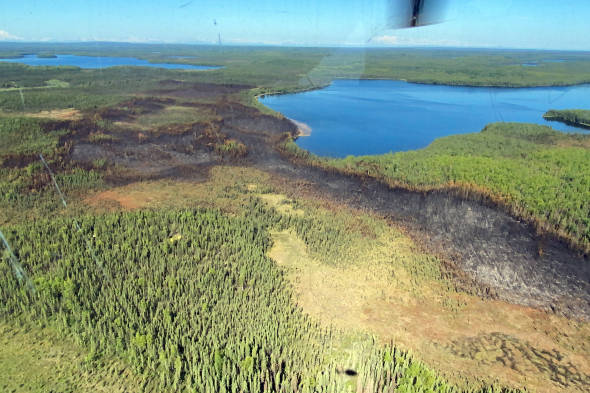Following the containment of the 102-acre Loon Lake Fire northeast of Sterling last weekend, Jeff Bouschor, the fire management officer at the Kenai National Wildlife Refuge, created an informational video to answer questions on what this summer’s fire season will look like.
“Our fire seasons are becoming longer,” he said. “Climate change is a real thing here on the Kenai Peninsula.”
Bouschor said the peninsula is known both for experiencing fires more frequently and producing larger-scale fires.
“We can’t suppress every fire that starts on the Kenai National Wildlife Refuge,” he said.
There are multiple reasons for that, Bouschor said, including challenges with heavy fuel loading, burning in dense areas, more infrastructure to protect and the risk posed to firefighters.
Another way land management officials aim to relieve some of the strain of the fire season is through pre-planning and prioritization.
Bouschor described this as prioritizing the fires that have the potential to cause the most harm to people and wildlife, using more resources on critical fires and creating fuel breaks in potentially hazardous areas. In the recent Loon Lake Fire, he said, officials used some of these strategies.
“There were plenty of resources available for us to choose the strategy that we did and that allowed us to go full suppression,” he said.
Bouschor and Drew Anderson, the Soldotna forestry lead fire prevention officer, encouraged people to “firewise” their homes by removing flammable vegetation, tending to controlled fires and fully extinguishing them at the end.
“We kind of recommend people burn slash in the winter months where escapement won’t happen, but if you do choose to burn during the summer months, following the regulations in the burn permits will keep you safe and legal,” Anderson said.
He said in a follow-up interview with the Clarion that it’s safest to burn in the winter when there are heavy precipitation levels, and that taking flammable materials to the landfill is always another safe alternative.
Looking forward, Anderson said he can’t make many predictions about this summer’s fire season, but wanted to encourage people to be aware of the risks and regulations of burning. He said debris fires are the No. 1 cause of wildfire on the peninsula.
“It’s hard to outlook … It’s all kind of dependent on weather leading up to those fires,” he said.
For more information, contact the Kenai and Kodiak Area Division of Forestry at 907-260-4200.
Reach reporter Camille Botello at camille.botello@peninsulaclarion.com.

